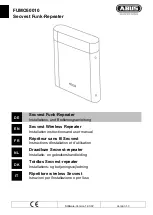
CAMPO EQUIPMENT CO. LTD. (ECOBLAZE)
6 Carson Court, Brampton, ON, CANADA, L6T 4P8
Tel: (905) 793-2525 | Fax: (905) 793-8768 |
pg. 11
TESTING ELECT. COMPONENTS
Common sense and careful thought can make
troubleshooting of electrical problems much
less complicated. Remembering that electricity
must have a completed path for it to work is the
first necessary understanding. Secondly,
search for the problem by looking at the most
obvious solution first; then look toward the
more complicated solutions. Use the
appropriate wiring diagram as a guide for
isolating the problem.
If ignition problems of the burner are
encountered, for instance, use the following
example as a guide.
1. Check the breakers and switches.
2. Check gas supply lines and manual valves,
and fuel availability.
3. Check for proper output voltage from power
source.
4. Check to be sure all wire connections are
tight.
5. Remove the electrode and check its
condition. If worn, replace. If improperly
adjusted, adjust the separation and
extension to within specifications.
The following is the method for testing major
electrical components.
WARNING
A qualified electrician should perform all
tests, replacements, and adjustments.
Testing the Main Switch
Before assuming the Control Switch to be
defective, check the breaker to be sure it is
good. Secondly, be sure to check the wiring
connections and wires to be sure the
connections are tight, and wires are good.
Remember that the blower must be operating
properly for the burner to operate. The switch
can be tested using an ohmmeter.
To test, use the following procedure:
1. Disconnect the main power supply, open
the Electrical Compartment.
2. Set the ohmmeter in the continuity test
mode.
3. With the main switch in OFF position, place
one tester lead on the common contact and
one tester lead on the contact relative to the
switch position. Place the switch to “ON’
position. The meter must show continuity.
4. With the HEAT/FAN switch in
‘HEAT’
position, place one tester lead on the
common contact and one tester lead on the
contact relative to the switch position. The
meter must show continuity on the relative
contact.
Intermittent Pilot Gas Ignition Control
• Natural or LP gas
• Pilot burner ignition using an external ignitor
• Flame rectification circuit to monitor flame
presence.
• Monitoring of 120V, pilot, and main gas valve.
• Five LED indicators for:
•
Running interlock
•
Recycle/airflow
•
Trial for ignition
•
Flame
•
Alarm
WARNING
Never touch the flame rod or the wire
leading to it while power is ON. The
amplifier charges the flame rod with
approximately 300 volts AC. Serious
personal injury could result!
Testing Air Pressure Differential Switch
The DF1600 uses an air pressure differential
switch to confirm that the main blower is
moving enough air through the heater.
This switch must be activated before the burner
will ignite. The switch senses the difference
between the velocity developed by the blower.
Any restrictions beyond the set point limit
of the switch to the inlet of the heater will
cause the switch to open and shut the





































